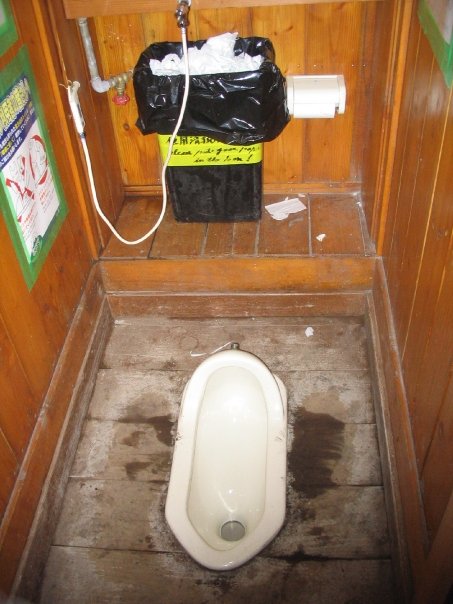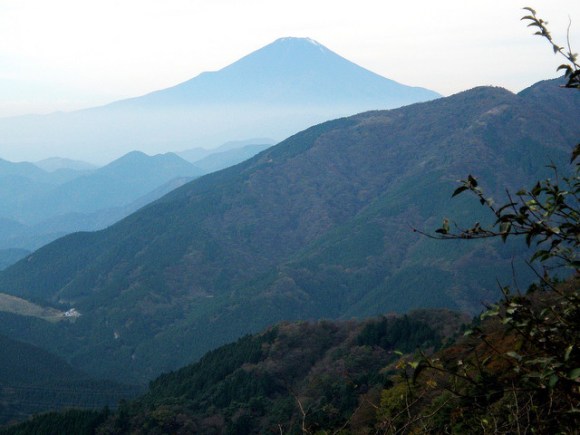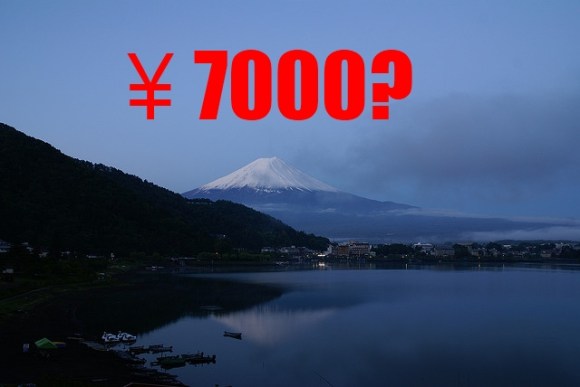Mount Fuji, Japan’s highest and much-climbed mountain, has lately been acknowledged as a priceless part of the world’s cultural heritage. But a climb to appreciate this heritage may now come with the hefty price tag of 7,000 yen (about US$70) per person.
If you only make it half way up, how about a half price discount?
With the sacred mountain on the verge of attaining UNESCO World Heritage status, the number of climbers could skyrocket, placing additional strain on an environment which some say is already pushed to the limit. The results of a preliminary study on the issue conducted by Kyoto University’s Professor Koichi Kuriyama (Environmental Economics) were released on June 4. Professor Kuriyama came to the conclusion that to keep the number of climbers at current levels, “a 7,000 yen fee per person is necessary”.
To estimate how the number of visitors would decrease if a fee to climb the mountain was to be introduced, the study used statistical analysis to quantify the relationship between the number of climbers and the time and cost of travel.
Calculations showed that a 500 yen (US$5.13) entry fee should decrease the number of climbers by 2%, a 1,000 yen (US$10.26) fee by 5%, a 7,000 yen (US$71.80) fee should result in the same number of climbers as last year, and slapping on a 10,000 yen (US$102.56) fee should lower numbers to a mere 90% of last year’s approximately 318,000 climbers. We can only speculate as to how much the fee would need to be increased to make people run away from the mountain rather than climb it. Why stop there? Why not double or triple it?
Professor Kuriyama also notes that it’s not realistic that the entry fee alone will check the number of climbers, but a small entry fee could go towards preserving the environment and accident prevention. From my personal experience climbing Mt Fuji, I think this is a great idea. Especially the accident prevention. Particularly in the well-used toilets.

I mean, if the issue in question is just the number of climbers, how about introducing some kind of quota system?
Japanese netizens responded with a wide range of opinions:
“It’d be better to charge 3,776 yen…” (1 yen per meter of mountain height. This could have the additional benefit of forcing people to recognise that Mt Fuji is really a very high, serious mountain, and come prepared)
“No matter how much you charge, if climbers don’t behave with decency and good manners, this won’t change a thing.”
“It doesn’t seem right that the number of climbers has to be kept down because it’s being listed as cultural heritage.”
“That’s so expensive! It’ll probably reduce the number of visitors, but it’s too expensive.”
“I think that’s about right. Given that there are already too many climbers.”
“What if we make everyone pay 7,000 yen, and we end up with a lot of climbzillas, who start saying things like ‘It’s ridiculous to carry trash back home’ and ‘I already paid the cleaning fee!’”
The 7,000 yen fee does seem expensive, so climbing Mt Fuji may not be undertaken lightly in the future. If this is how it has to be, if this symbol of Japan is removed from the reach of people who are unable or unwilling to pay so much, would it have been better if it never became World Heritage listed at all?
There’s a Japanese proverb on the subject—“You’re a fool if you never climb it, and a fool if you climb it twice.” At this rate, if you climb Mount Fuji twice, you must be an idiot. But before we complain too much, Mount Kilimanjaro charges a similar amount per day of climbing, while if you raise your sights to Mount Everest you’re looking at a cool $35,000-$100,000. Mount Blanc will set you back a few thousand dollars. Given today’s economic climate, you might be better off getting one of those pens instead…


Source: jin115
Featured image by palindrome6996
Other images by Rona Moon, RocketNews24


 Mount Fuji plans to start charging compulsory fee to climbers
Mount Fuji plans to start charging compulsory fee to climbers Mount Fuji has become so congested with tourists that it has reached breaking point
Mount Fuji has become so congested with tourists that it has reached breaking point Hiker falls off Mt. Fuji while live-streaming steps from summit, rescuers yet to find him【Video】
Hiker falls off Mt. Fuji while live-streaming steps from summit, rescuers yet to find him【Video】 Live-streamer who slipped and died on Mt Fuji wins Darwin Award
Live-streamer who slipped and died on Mt Fuji wins Darwin Award “Miraculous” cloud over Mt Fuji stuns the Internet
“Miraculous” cloud over Mt Fuji stuns the Internet Red light district sushi restaurant in Tokyo shows us just how wrong we were about it
Red light district sushi restaurant in Tokyo shows us just how wrong we were about it Japan’s massive matcha parfait weighs 6 kilos, contains hidden surprises for anyone who eats it
Japan’s massive matcha parfait weighs 6 kilos, contains hidden surprises for anyone who eats it Sandwiches fit for a sumo served up in Osaka【Taste Test】
Sandwiches fit for a sumo served up in Osaka【Taste Test】 Tokyo Tsukiji fish market site to be redeveloped with 50,000-seat stadium, hotel, shopping center
Tokyo Tsukiji fish market site to be redeveloped with 50,000-seat stadium, hotel, shopping center Pokémon Sleep camping suite and guestrooms coming to Tokyo Hyatt along with giant Snorlax burgers
Pokémon Sleep camping suite and guestrooms coming to Tokyo Hyatt along with giant Snorlax burgers McDonald’s new Happy Meals offer up cute and practical Sanrio lifestyle goods
McDonald’s new Happy Meals offer up cute and practical Sanrio lifestyle goods Haku is…Chihiro’s dead brother? Studio Ghibli fans blown away by Spirited Away theory
Haku is…Chihiro’s dead brother? Studio Ghibli fans blown away by Spirited Away theory Studio Ghibli releases new action figures featuring Nausicaä of the Valley of the Wind characters
Studio Ghibli releases new action figures featuring Nausicaä of the Valley of the Wind characters Japanese clothes retailer GU announces stylish, nostalgic PlayStation line, available now
Japanese clothes retailer GU announces stylish, nostalgic PlayStation line, available now Historical figures get manga makeovers from artists of Spy x Family, My Hero Academia and more
Historical figures get manga makeovers from artists of Spy x Family, My Hero Academia and more All-you-can-drink Starbucks and amazing views part of Tokyo’s new 170 meter-high sky lounge
All-you-can-drink Starbucks and amazing views part of Tokyo’s new 170 meter-high sky lounge More foreign tourists than ever before in history visited Japan last month
More foreign tourists than ever before in history visited Japan last month Japanese ramen restaurants under pressure from new yen banknotes
Japanese ramen restaurants under pressure from new yen banknotes French Fries Bread in Tokyo’s Shibuya becomes a hit on social media
French Fries Bread in Tokyo’s Shibuya becomes a hit on social media New private rooms on Tokaido Shinkansen change the way we travel from Tokyo to Kyoto
New private rooms on Tokaido Shinkansen change the way we travel from Tokyo to Kyoto Starbucks reopens at Shibuya Scramble Crossing with new look and design concept
Starbucks reopens at Shibuya Scramble Crossing with new look and design concept Studio Ghibli glasses cases let anime characters keep an eye on your spectacles
Studio Ghibli glasses cases let anime characters keep an eye on your spectacles Beautiful Ghibli sealing wax kits let you create accessories and elegant letter decorations【Pics】
Beautiful Ghibli sealing wax kits let you create accessories and elegant letter decorations【Pics】 Studio Ghibli releases Kiki’s Delivery Service chocolate cake pouches in Japan
Studio Ghibli releases Kiki’s Delivery Service chocolate cake pouches in Japan New definition of “Japanese whiskey” goes into effect to prevent fakes from fooling overseas buyers
New definition of “Japanese whiskey” goes into effect to prevent fakes from fooling overseas buyers Our Japanese reporter visits Costco in the U.S., finds super American and very Japanese things
Our Japanese reporter visits Costco in the U.S., finds super American and very Japanese things Studio Ghibli unveils Mother’s Day gift set that captures the love in My Neighbour Totoro
Studio Ghibli unveils Mother’s Day gift set that captures the love in My Neighbour Totoro New Japanese KitKat flavour stars Sanrio characters, including Hello Kitty
New Japanese KitKat flavour stars Sanrio characters, including Hello Kitty New Pokémon cakes let you eat your way through Pikachu and all the Eevee evolutions
New Pokémon cakes let you eat your way through Pikachu and all the Eevee evolutions Disney princesses get official manga makeovers for Manga Princess Cafe opening in Tokyo
Disney princesses get official manga makeovers for Manga Princess Cafe opening in Tokyo Sales of Japan’s most convenient train ticket/shopping payment cards suspended indefinitely
Sales of Japan’s most convenient train ticket/shopping payment cards suspended indefinitely Sold-out Studio Ghibli desktop humidifiers are back so Totoro can help you through the dry season
Sold-out Studio Ghibli desktop humidifiers are back so Totoro can help you through the dry season Japanese government to make first change to romanization spelling rules since the 1950s
Japanese government to make first change to romanization spelling rules since the 1950s Ghibli founders Toshio Suzuki and Hayao Miyazaki contribute to Japanese whisky Totoro label design
Ghibli founders Toshio Suzuki and Hayao Miyazaki contribute to Japanese whisky Totoro label design Doraemon found buried at sea as scene from 1993 anime becomes real life【Photos】
Doraemon found buried at sea as scene from 1993 anime becomes real life【Photos】 Tokyo’s most famous Starbucks is closed
Tokyo’s most famous Starbucks is closed One Piece characters’ nationalities revealed, but fans have mixed opinions
One Piece characters’ nationalities revealed, but fans have mixed opinions We asked a Uniqlo employee what four things we should buy and their suggestions didn’t disappoint
We asked a Uniqlo employee what four things we should buy and their suggestions didn’t disappoint Princesses, fruits, and blacksmiths: Study reveals the 30 most unusual family names in Japan
Princesses, fruits, and blacksmiths: Study reveals the 30 most unusual family names in Japan Fuji Dream Airlines is offering limited Mt. Fuji sightseeing flights
Fuji Dream Airlines is offering limited Mt. Fuji sightseeing flights Mt. Fuji is now open again following 2020 shutdown
Mt. Fuji is now open again following 2020 shutdown 14 tips for visiting the Mt Fuji Shibazakura Festival, where beautiful “lawn sakura” blossom
14 tips for visiting the Mt Fuji Shibazakura Festival, where beautiful “lawn sakura” blossom U.S. servicemen’s hike on Mount Fuji turns into rescue mission, netizens are awed and grateful
U.S. servicemen’s hike on Mount Fuji turns into rescue mission, netizens are awed and grateful Mt Fuji looks unusual, sparks fears of possible eruption
Mt Fuji looks unusual, sparks fears of possible eruption Hike from the sea to the peak of Mt. Fuji with new bilingual English/Japanese guide map series
Hike from the sea to the peak of Mt. Fuji with new bilingual English/Japanese guide map series Search for live-streamer who fell from Mt. Fuji finds badly damaged corpse half-mile below peak
Search for live-streamer who fell from Mt. Fuji finds badly damaged corpse half-mile below peak Geographical Survey Institute posts 184 images of Mount Ontake eruption online
Geographical Survey Institute posts 184 images of Mount Ontake eruption online Japan now has Mt Fuji bread!
Japan now has Mt Fuji bread! Japanese prefectural governor wants foreign tourists to pay special extra fee
Japanese prefectural governor wants foreign tourists to pay special extra fee The top 5 places to see the sun set in Japan
The top 5 places to see the sun set in Japan Hiking restrictions result in huge drop in climbing accidents, with zero on Mt. Fuji
Hiking restrictions result in huge drop in climbing accidents, with zero on Mt. Fuji “Floating” Mt Fuji and shrine gates capture the hidden beauty of Japan【Photos】
“Floating” Mt Fuji and shrine gates capture the hidden beauty of Japan【Photos】 Mt. Fuji is officially closed for the year
Mt. Fuji is officially closed for the year
Leave a Reply